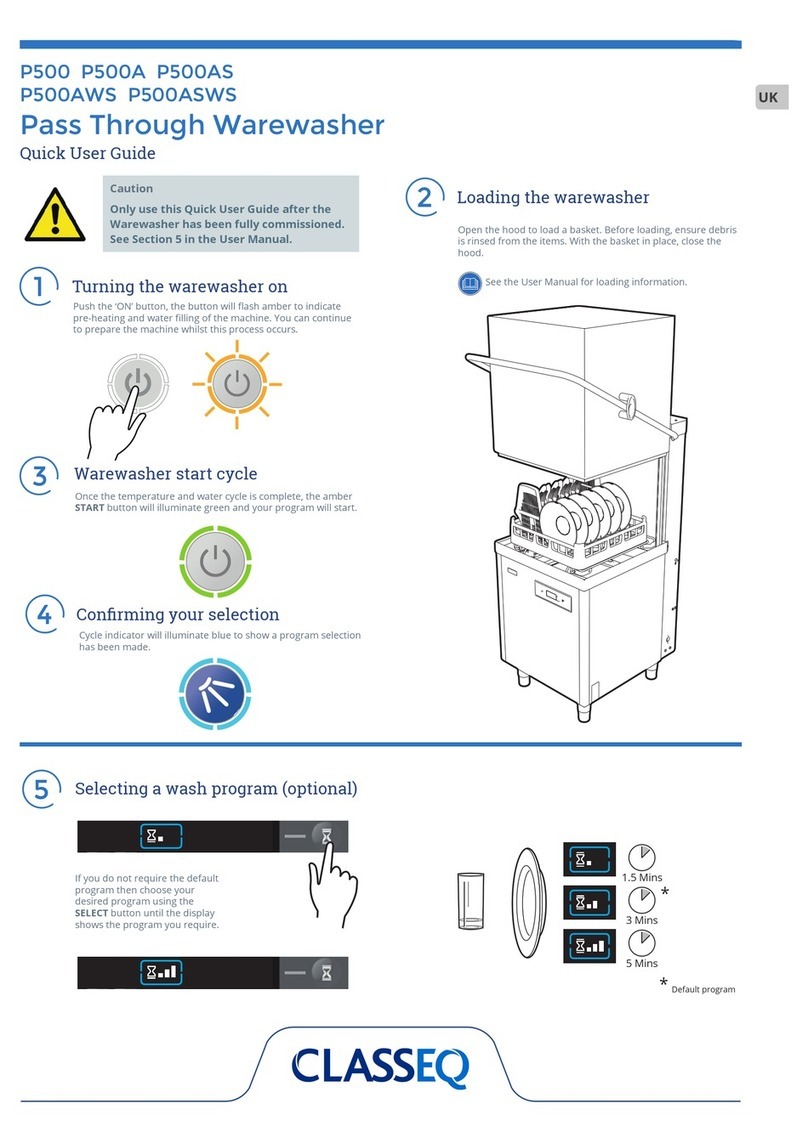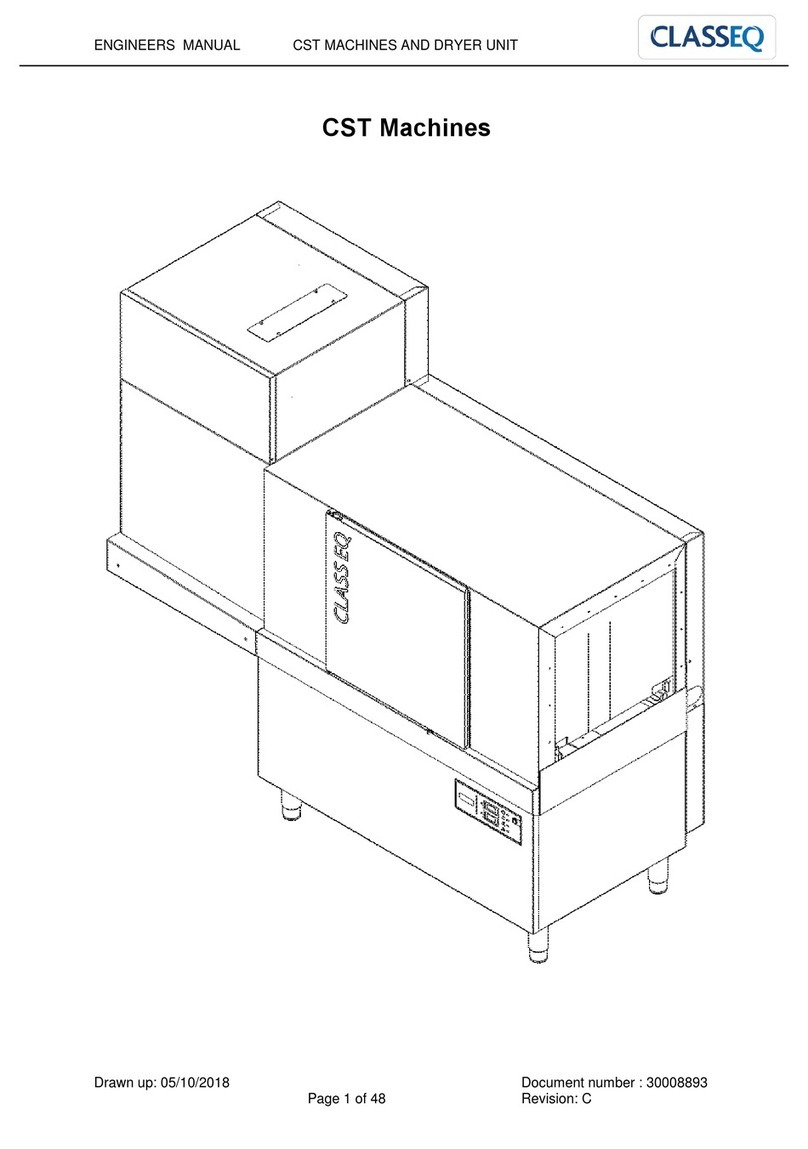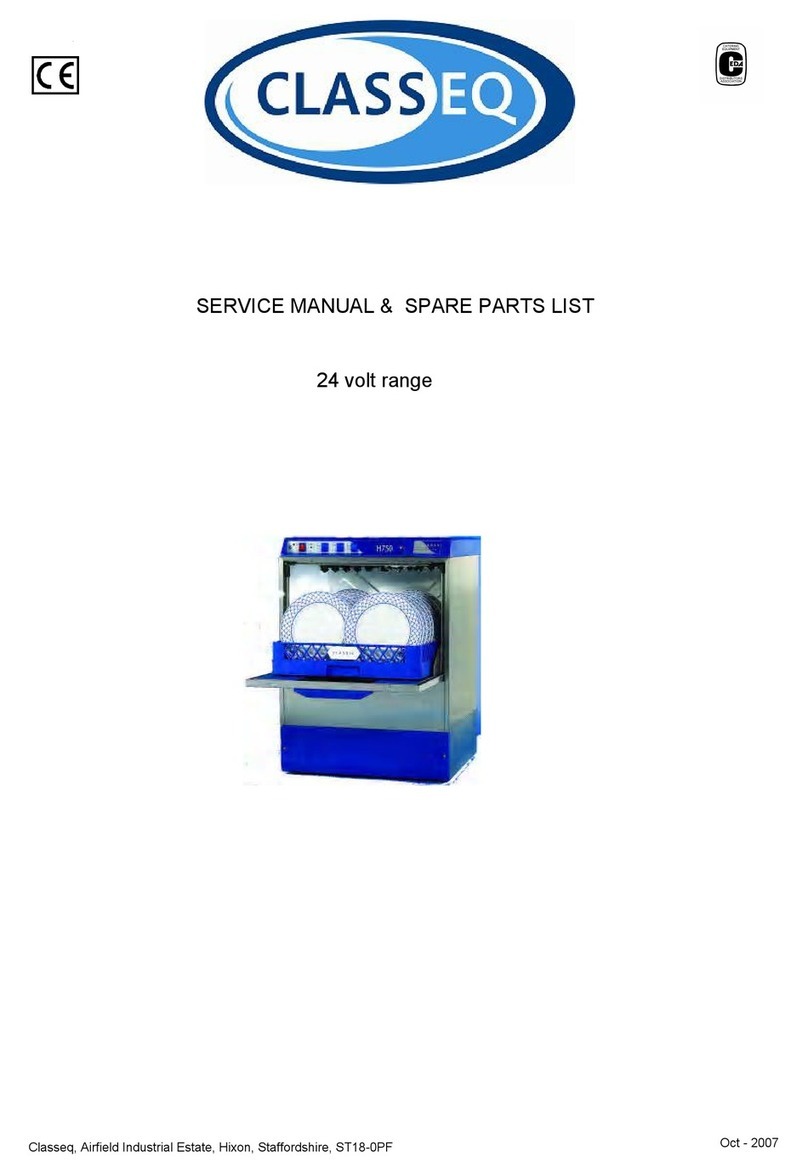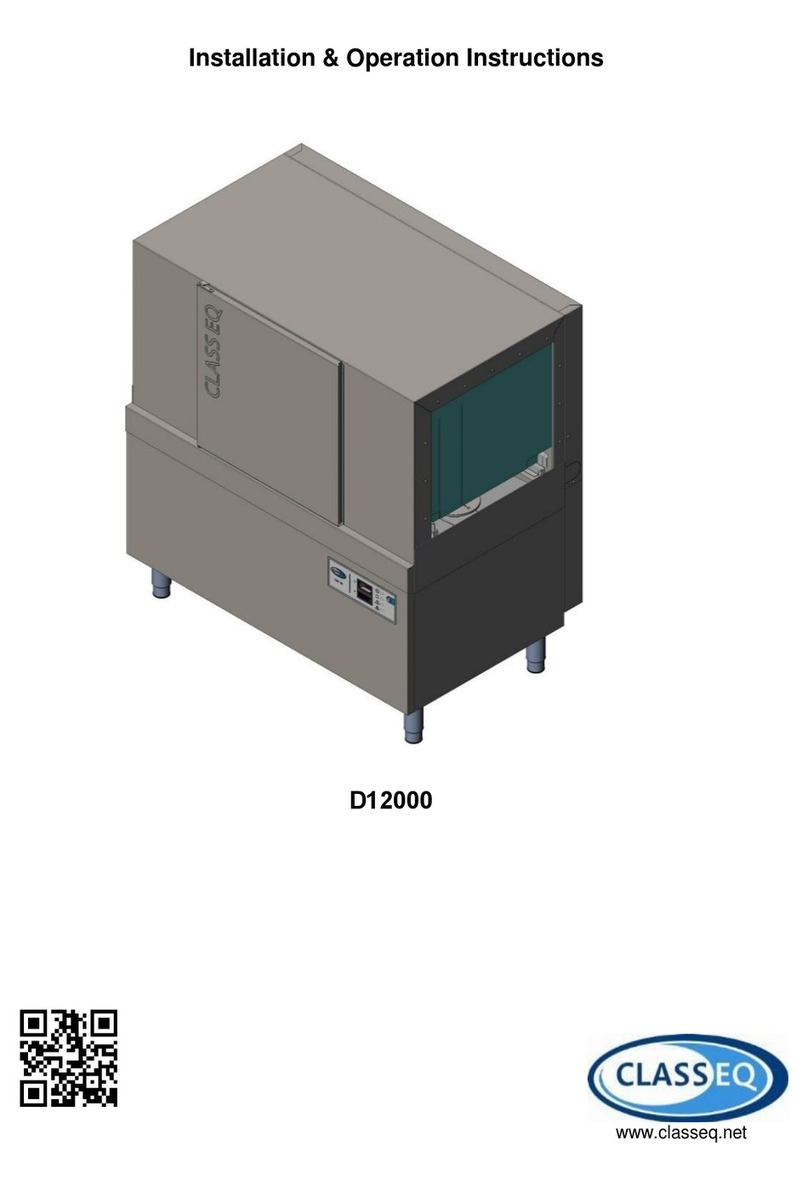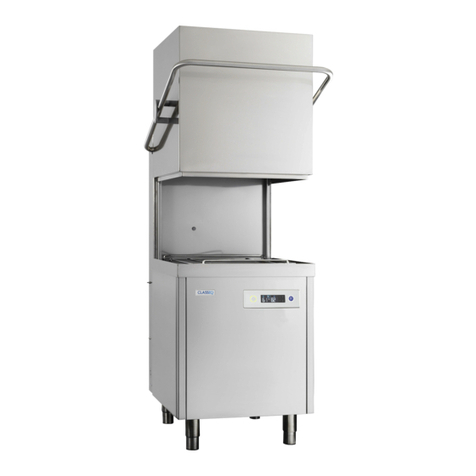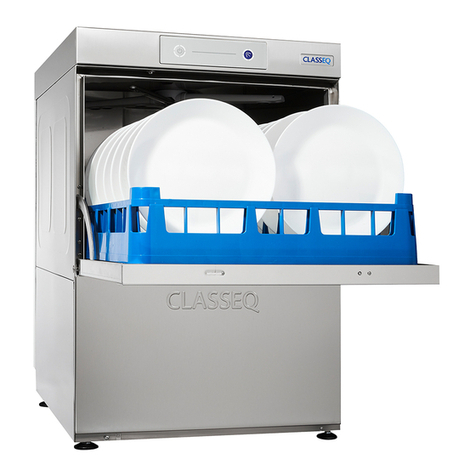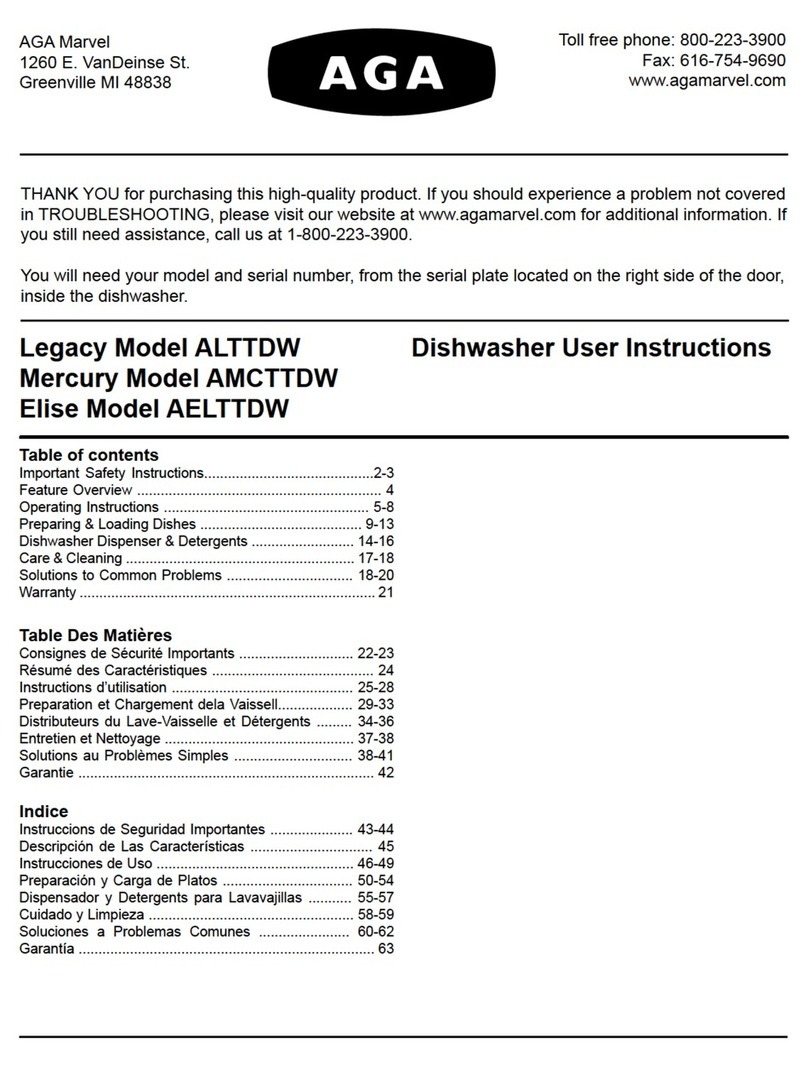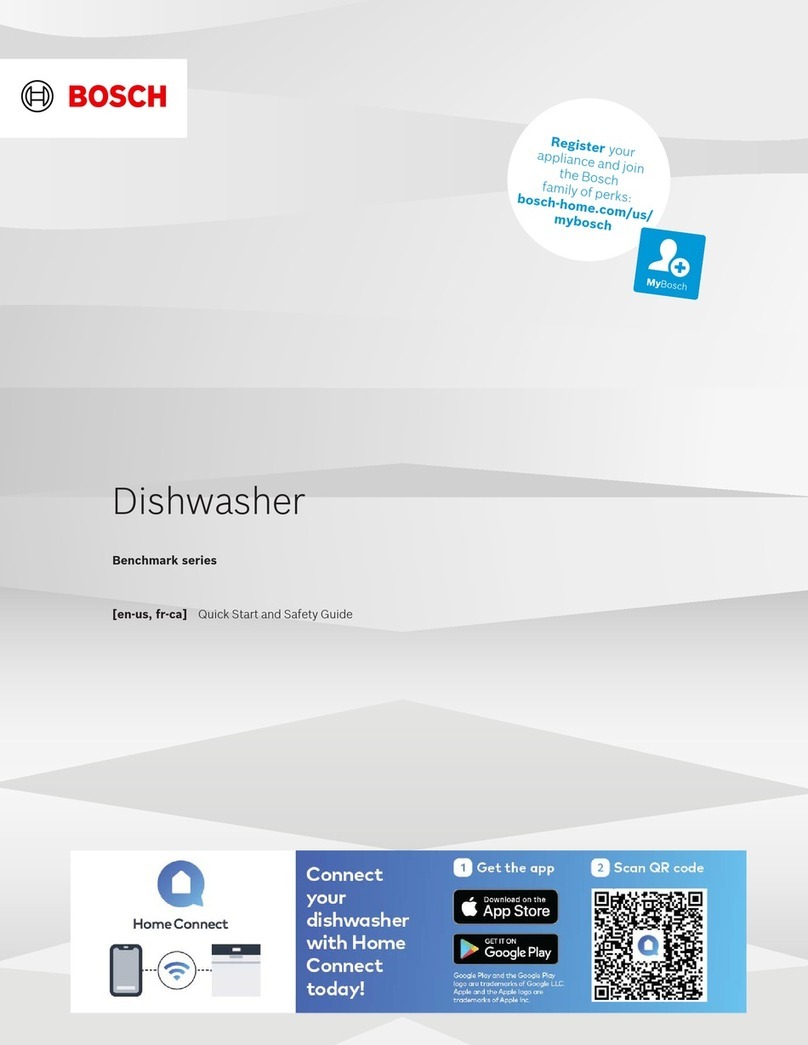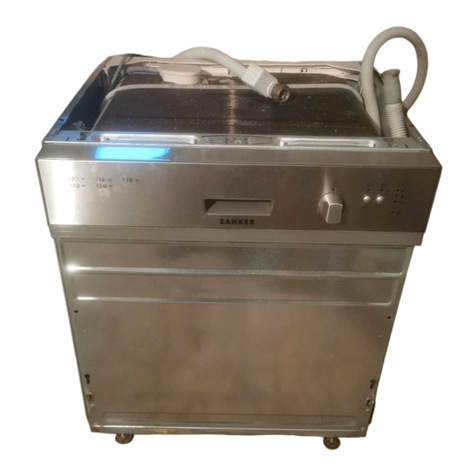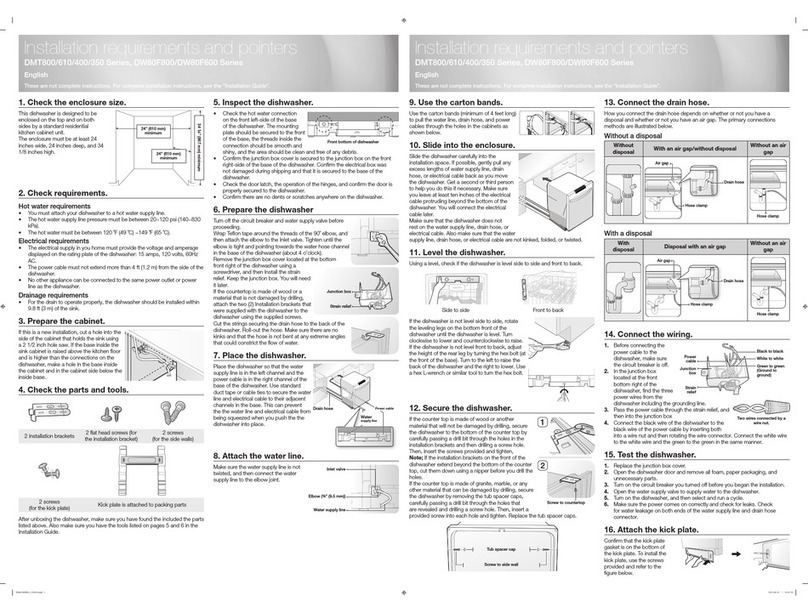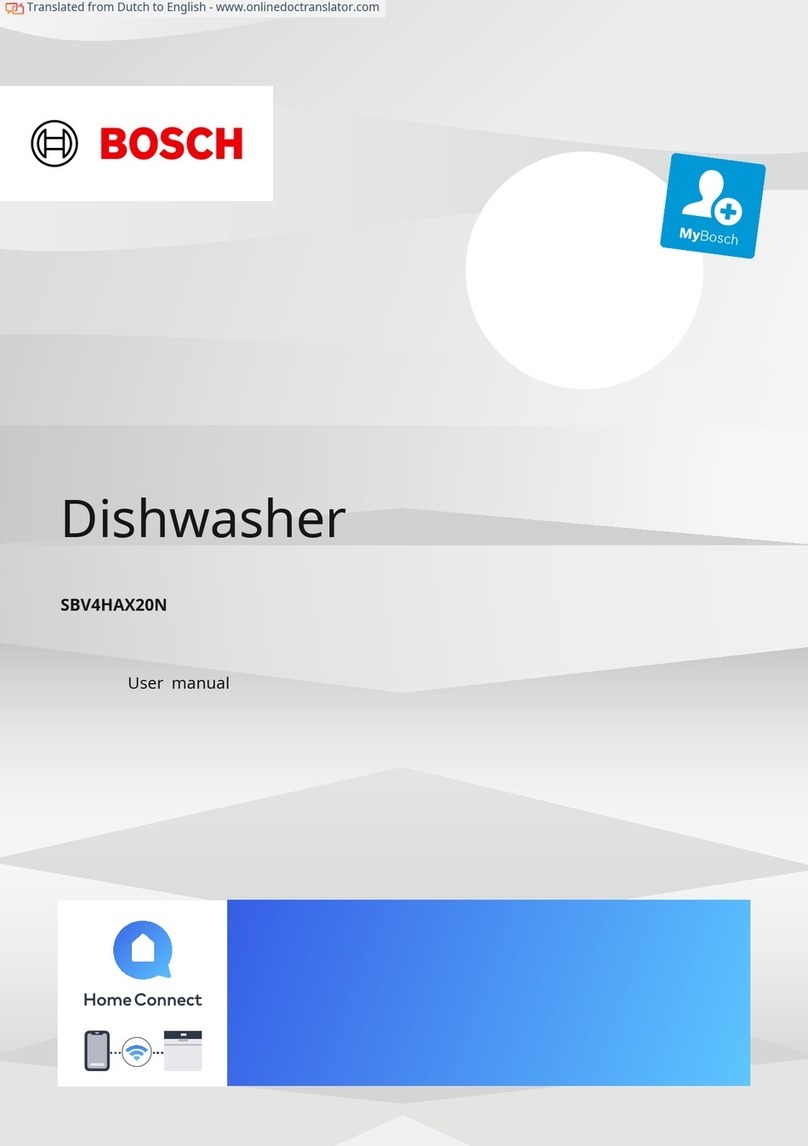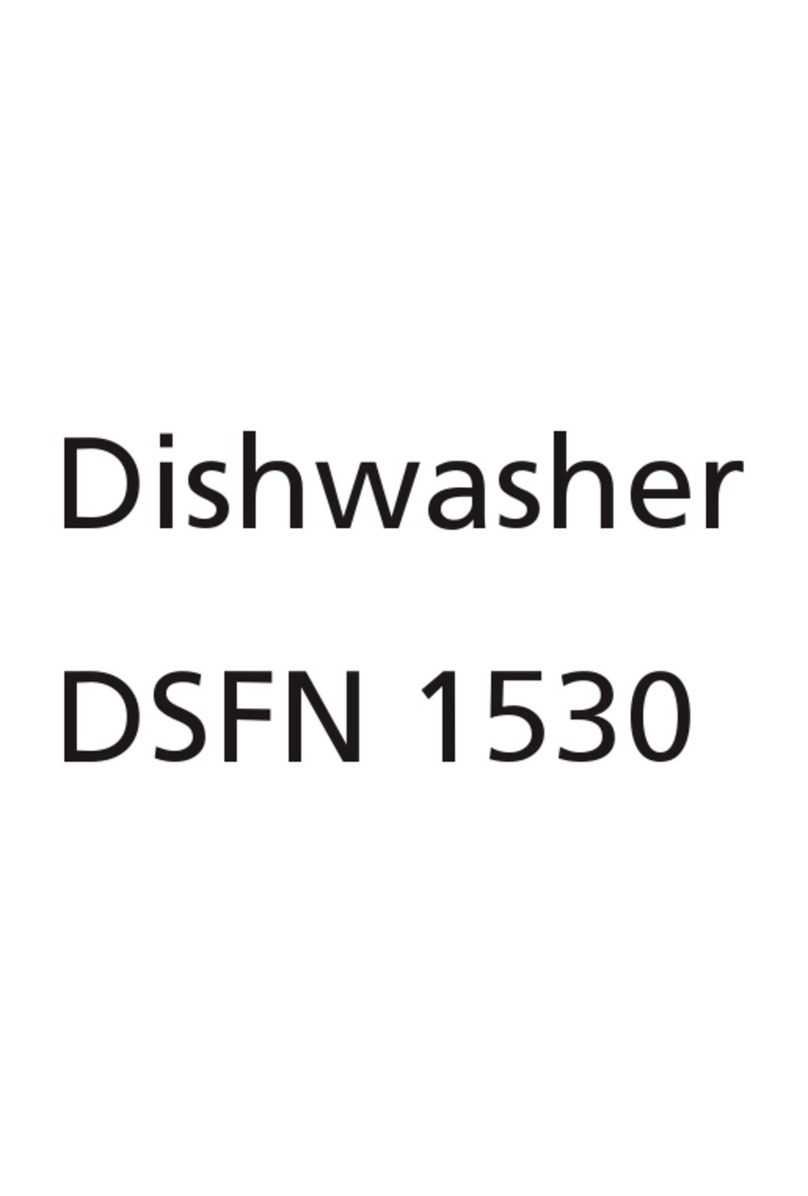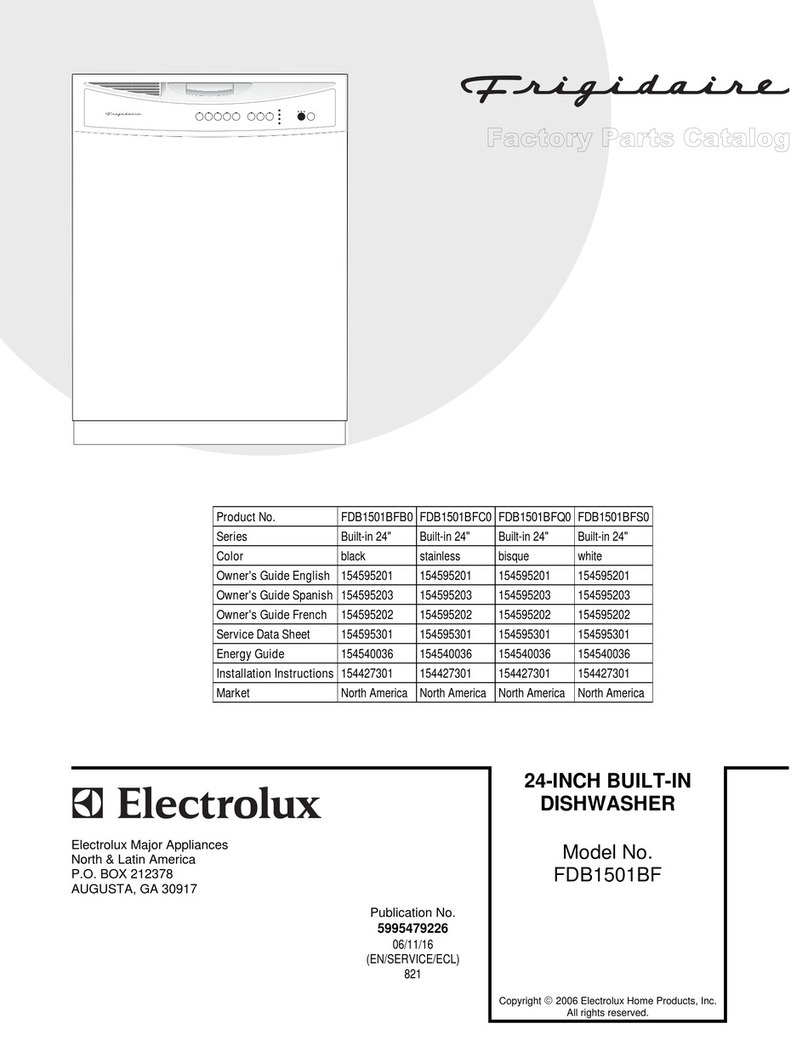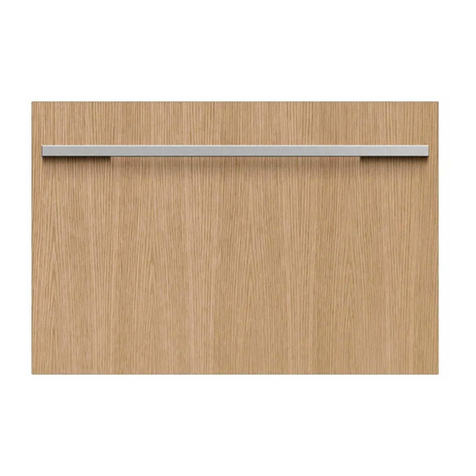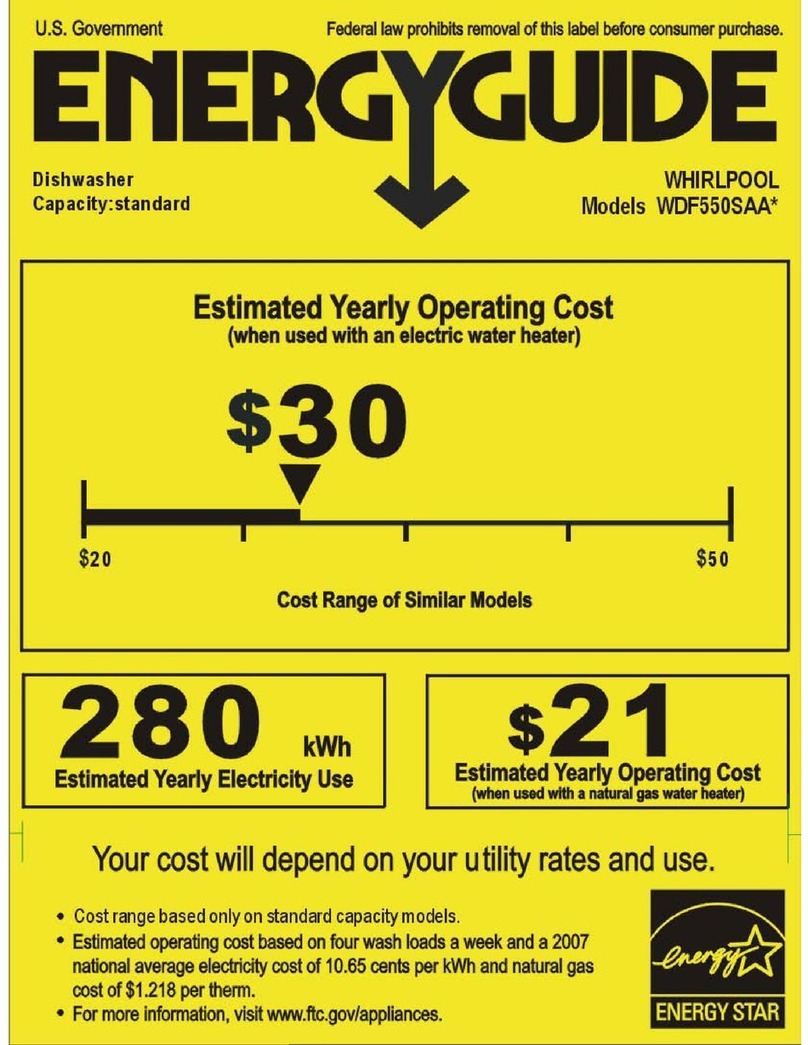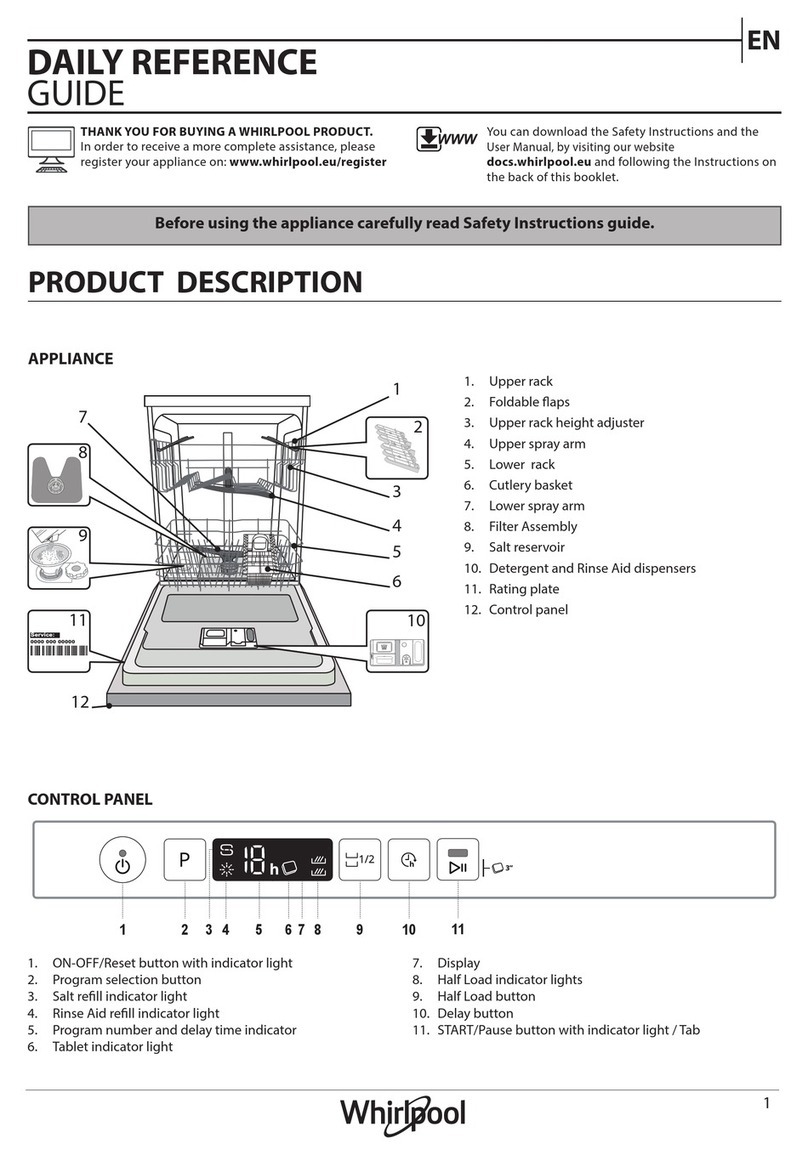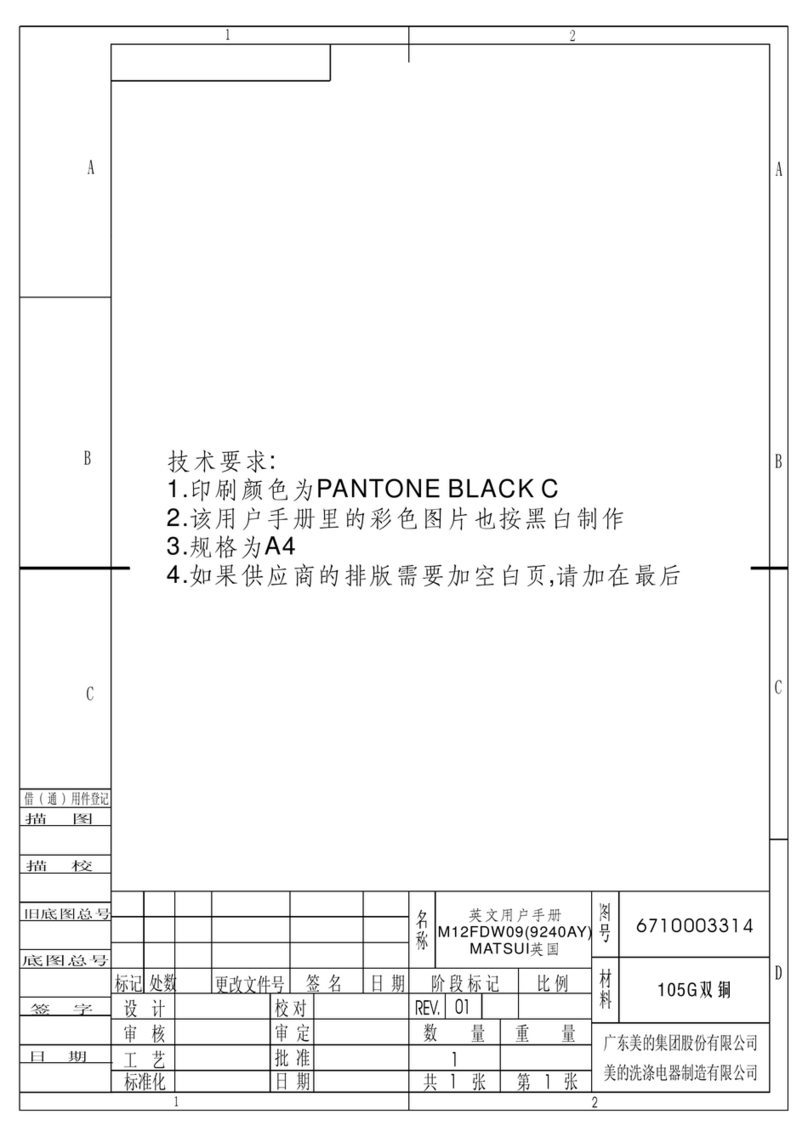Classeq G 350 User manual

Installation and
operation manual
Under counter machines
CAUTION: Read these instructions before operating the machine

Page 1
Dear Customer,
Thank you for choosing Classeq, the machine you have selected has been designed to give you
lasting service.
Please read these instructions before installing, commissioning and operating this machine.
The information contained herein is provided to avoid accidental risks and/or damage to either
yourself or your machine.
Make sure you and any other users understand the controls prior to using your machine.
Please keep these instructions in a safe place for future reference.
If you have any questions, or are not sure about any information contained in this manual please
contact either your distributor or Classeq, in the ‘Useful contact details’ section of this manual
(►14).

Page 2
TABLE OF CONTENTS
1. EXPLANATION OF SYMBOLS USED................................................ 3
2. WARNING AND SAFETY INFORMATION ......................................... 4
3. KNOW YOUR MACHINE..................................................................... 6
4. PRE-INSTALLATION .......................................................................... 9
5. INSTALLATION................................................................................. 11
6. COMMISSIONING ............................................................................. 13
7. OPERATION...................................................................................... 15
8. SERVICE AND MAINTENANCE....................................................... 17
9. TROUBLESHOOTING....................................................................... 19
10. DECOMMISSIONING ........................................................................ 21
11. APPENDIX C –MACHINE SPECIFICATIONS................................. 22
12. PARTS AND LABOUR WARRANTY................................................ 24
13. NOTES............................................................................................... 25
14. USEFUL CONTACT DETAILS.......................................................... 26

Page 3
1. Explanation of symbols used
The following symbols have been used in this manual
DANGER!
Warning against potentially
serious or fatal injuries to
persons if the described
precautionary measures are not
taken.
►
This symbol refers to a
chapter with more detailed
information
Warning!
Warning against potentially
minor injuries to persons or
material damage if the
described precautionary
measures are not taken
.
1
Refer to foot note at bottom
of page
Caution
Warning against defects in or
destruction of the product if the
described precautionary
measures are not taken.
Recycle

Page 4
2. Warning and safety information
2.1 Danger warnings
For safety reasons your machine MUST be bonded to adjacent
metalwork or earthed so that it is at the same potential (i.e.
voltage) (►4.1).
A means for disconnection that has an all pole seperation of
more than 3mm must be incorporated in the fixed wiring in
accordance with wiring rules (►4.2).
All mains electrical work must be carried out in accordance with
local and national regulations, and by a qualified electrician
(►5.2.1).
The machine MUST be disconnected from its power source
during cleaning, servicing or replacing parts (►8).
Ensure the base of the machine is never submerged or standing
in water when operating the machine (►8).
2.2 Warnings
The machine should only be operated at or within the voltage
specified on the rating plate (►3.1).
Old existing, defective or damaged water supply hoses are NOT
to be used when installing your machine (►4.3.1).
The installer and user are responsible for ensuring the installation
and operation of this machine are in accordance with this manual
and local and national regulations (►5).
DO NOT use electrical extension lead(s) to supply power to your
machine (►5.2.1).
Children should be supervised to ensure that they do not play
with, or operate the machine (►7).
Be aware: Wares may be hot when removed from machine
(►7.6).
Before cleaning the wash chamber, ensure all sharp items, such
as broken glass or other items which could cause injury are
removed carefully (►8.1).
DO NOT use cleaning agents that contain CHLORINE, BLEACH
or HYPOCHLORITE (►8.1).
Wear protective clothing, protective gloves and protective

Page 5
goggles when handling chemicals and observe all safety notes
and dosing recommendations printed on their packaging (►5.5)
(►8.4).
If the machine is being drained immediately after use, water
draining from the ‘Boiler drainage hose’ may reach over 85°C
(►10).
2.3 Cautions
Only use commercial grade detergents and rinse-aids within your
machine (►5.5).
Always remove excess food/debris from any dishes/glasses to be
washed. DO NOT use your machine as a waste disposal unit
(►7.6).
It is very important the machine is drained down at the end of
each working day (►7.7).
DO NOT use STEEL WOOL, WIRE BRUSHES or any other
abrasive materials (►8.1).
Damage to the machine caused by lime scale, or poor water
quality will NOT be covered by the Manufacturer’s Warranty
(►8.3).
De-scale must not remain in the machine for more than 2 hours
(►8.4).
Ensure that the items placed on the open door of the machine do
not exceed 20kg in weight (►8).

Page 6
3. Know your machine
Before installing your machine you should familiarise yourself with the various components shown
below. For detailed machine specifications see Appendix C (►11)
3.1 Machine layout
Item
Description
1
Door1
2
Primary filters
3
Bottom wash and rinse arms
4
Top wash and rinse arms2
5
User interface
6
Anti-syphon device3
7
Basket ramp
8
Rating plate
9
Secondary filters
10
Drain plug4
1
The door of the machine should NEVER be used as a step or seat.
2
Fitted as required for Glass & Dish washer models
3
Pumped drain machines only.
4
Gravity drain machines only.

Page 7
3.2 User interface
Item
Description
1
On/Off button
2
Cycle button
3
Cycle indicator
4
Heating indicator
5
Hidden until lit display
6
Commissioning button B
7
Commissioning button C
1
4
5
6
7
3
2

Page 8
3.3 Accessories with your machine
Items included within machine
5
Installation and
operation manual
Good practice guide
Open basket
x2 Glass washer
x1 Dishwasher
Plate basket
x1 Dishwasher only
Cutlery basket
x1 Dishwasher only
Right hand primary
filter6
x1
Left hand primary
filter
x1
Secondary filters7
x2
Drain plug8
x1
Bottle weights
x2
Water inlet hose
x1
Waste hose hook9
x1
5
Images are for reference only, actual parts may differ
6
Differs depending on drain type
7
Only 1 on gravity drain machines
8
Only on gravity drain machines
9
Only on pumped drain machines

Page 9
4. Pre-installation
After unpacking your machine, check it for
any possible transport damage. Never
install and use a damaged machine. If your
machine is damaged contact your retailer
immediately.
Make sure the water and electricity
connections of your machine are in
compliance with these instructions.
Remove all outer packaging and the
protective film from your machine before
positioning it.
Ensure all packaging materials are
disposed of in accordance with local and
national regulations.
4.1 Equipotential bonding
DANGER!
For safety reasons your
machine MUST be bonded
to adjacent metalwork or
earthed so that it is at the
same potential (i.e. voltage).
Consult your distributor, Classeq or a
qualified electrician if you are unsure how to
do this.
4.2 Electrical connection
Prior to connecting the machine, ensure
that the voltage and the supply fuse comply
with the rating of the machine.
A means for disconnection that has an all
pole separation of more than 3mm must be
incorporated in the fixed wiring in
accordance with wiring rules.
Electrical cable specification4.2.1
If the mains electrical supply cable is
damaged or has deteriorated, it MUST be
replaced by a cable or cord assembly
supplied by Classeq, its service agents or
similarly qualified persons to avoid hazards,
and be to the following minimum
specifications.
Machine rating
(Volts / Phase / Amps)
Cable type
220-240V / 1N~/13A
H07RN-f 3G 1.5
220-240V / 1N~/28A
H07RN-f 3G 4.0
380-415V / 3N~/11A
H07RN-f 5G 2.5
Temp.
rating
Length
of
cable
Conforms to
80°C
min.
3m
IEC 60335-2-58
&
IEC 60227 types 56 & 57
For electrical rating of your machine refer to
the rating plate (►3.1).
Electrical connection4.2.2
specification
Depending on the specification of your
machine it may be supplied with or without
a moulded mains electrical plug.
4.3 Water connections
Commercial machine wash results may be
affected by external conditions such as
incoming water temperature, pressure,
hardness and choice of chemicals.
Water supply hose4.3.1
Classeq recommend installing a shut off
valve in the mains water supply line near
the machine such that it is easily accessible
(►11.2).
Your machine is supplied with a new WRAS
approved water hose (►3.3), requiring a
G¾” (¾” BSP) male threaded connection at
the mains water outlet.
Warning
Old existing, defective or
damaged water supply
hoses are NOT to be used
when installing your
machine.

Page 10
Water supply restrictions4.3.2
IMPORTANT - Install in accordance with
all applicable national water regulations.
Incoming water temperature:
4°C minimum
55°C maximum
Supply water dynamic pressure:
0 to 2 bar (0 to 200 kPa)
(External rinse booster pump required)
2 to 4 bar (200 to 400 kPa)
(No modifications required)
>4 bar (400 kPa)
(Pressure reducing valve required)
Minimum supply flow rate:
11 litres/minute
Water hardness:
For the longevity of your machine, and to
ensure you get consistently good results, it
is essential your machine is either fed from
a soft water supply (≤3°dH) or is connected
to an appropriate water softener.
IMPORTANT - All supplier warranties are
void if lime scale is present within your
machine.
Waste water connection4.3.3
The waste system of your machine will vary
depending on the variant. You can identify
the type of drain your machine has by
checking whether there is a drain plug
present (►3.1). Machines with a drain plug
are gravity drain and without are pumped
drain.
Gravity drain machines:
If your machine has a drain plug fitted in the
wash sump the waste hose will fit into
Ø40mm plumbing or over a Ø20mm spigot.
The hose for this machine has to lead away
below the base of the machine.
Pumped drain machines:
The waste hose of your machine will fit into
Ø40mm plumbing or over a Ø28mm spigot.
The waste plumbing for the machine can be
up to a maximum of the following heights
from the base of the machine:
Machine size
Max waste height (mm)
350mm
420
400mm
540
500mm
600

Page 11
5. Installation
Warning
The installer and user are
responsible for ensuring the
installation and operation of
this machine are in
accordance with this manual
and with local and national
regulations.
5.1 Machine placement
Your machine should be installed on the
stable surface that is capable of holding the
full weight of the machine (►11) and
withstand the vibration of regular use.
Ensure there is a minimum of 10mm
clearance each side of the machine and
with 20 mm clearance at the top and rear of
the machine. (►11).
Once installed use the adjustable feet to
ensure your machine is stable, with its
weight being distributed equally and does
not tilt more than 2°in any direction.
Your machine should be placed in a
location that allows the required supplies to
be fitted (►11.2).
When positioning the machine, ensure that
the water inlet, chemical tubes and drain
hoses are not kinked or squashed. Care
must also be taken to ensure your machine
does not rest upon any of its supply
hoses/leads.
5.2 Electrical connection
Mains cable connection5.2.1
Your machine must be connected directly to
the mains electricity using the mains
electrical cable provided. DO NOT use
electrical extension lead(s) to supply power
to your machine.
Prior to connecting your machine, ensure
the electrical supply has a suitable and
adequate circuit breaker/fuse. For the
electrical rating of your machine refer to the
rating plate (►3.1). Contact your
distributor, qualified electrician or Classeq
if you are unsure how to check this.
DANGER!
All mains electrical work
must be carried out in
accordance with local and
national regulations, and by
a qualified electrician
When hard wiring the machine into the
socket use the multimeter or voltmeter to
ensure that the connection point does not
have any voltage before attempting to
connect the terminals.
Equipotential bonding5.2.2
Your machine MUST be earth bonded to
adjacent metalwork or earthed so that it is
at the same potential (i.e. voltage).
The equipotential bonding stud is located at
the rear of the machine (►11.2) and has a
M5 nut fitted. Use the spanner to connect
the earth wire to this location and ensure
the nut is securely fastened.
5.3 Water supply hose connection
Connect the 90°bend end of the water
supply hose to your machine (►11.2) and
the straight end to your water mains supply.
Ensure the rubber seals within the ends of
the hose are in place.
Ensure all connections are water tight
before using your machine.

Page 12
5.4 Waste water connection
Fit the waste hose of your machine to the
site plumbing without kinking it.
Ensure that your hose is fitted to the
plumbing in a way that it will not come off or
out during the operation of the machine.
The waste plumbing must only be
connected into the foul drains and not the
surface water drainage system.
A form of back flow prevention must be
installed into the waste plumbing in
accordance with local and national
regulations.
Ensure that the waste hose of the machine
does not pass the height of the sticker on
the rear of the machine when the machine
is in place.
Where the machine is fitted to a stand pipe
the waste hose hook (►3.3) should be
used to help manage the hose
5.5 Fitting chemical bottles
Warning
Wear protective clothing,
protective gloves and
protective goggles when
handling chemicals and
observe all safety notes and
dosing recommendations
printed on their packaging
Caution
Only use commercial grade
detergents and rinse-aids
within your machine.
The chemical bottles should be placed in a
safe, stable location that is close to the
machine (►11.2) and easily accessed to
check chemical levels and replace the
bottles as needed.
A coil of PVC tube is connected to each of
the chemical pumps inside the machine.
These tubes exit the rear of the machine
and should be routed to the chemical bottle
locations, excess tube may be removed.
The tubes need to be long enough to allow
the bottles to be moved without the risk of
falling over.
Blue tube
Rinse aid
Clear tube
Detergent
Remove the cap from each of the chemical
bottles and use the drill to make a hole in
middle.
Feed the tube through the hole and fit the
bottle weights and filters supplied the end of
each tube before dropping them into the
chemical bottles and fastening the caps.
Bottle weight
Filter
Bottle cap
PVC hose from machine

Page 13
6. Commissioning
6.1 Commissioning interface
IMPORTANT –Only use Classeq appointed engineers
Item
Description
1
Exit button
2
Enter button
3
Cycle indicator
4
Heating indicator
5
Hidden until lit display
6
Up button
7
Down button
6.2 Commissioning mode
With the machine turned on at the mains
electrical supply but off at the display, press
and hold the Exit (1) and Enter (2) buttons
for 3sec. the display (5) will show the first
menu item and the cycle indicator (3) will
illuminate red.
If no buttons have been pressed for a
period of time the machine will cancel this
mode and return to the off state.
Below is the complete menu list.
Display
Description
**
Rinse aid setting (e.g. = 1.5mL/L)
Rinse aid prime
**
Detergent setting (e.g. = 3.3mL/L)
Detergent prime
** Refers to the setting of the chemical
dosing. For example the default setting for
rinse aid is 1ml of chemical per litre of water
this will be displayed as ‘ ’ the default
setting for detergent is 3ml of chemical per
litre of water this will be displayed as ‘ ’
1
5
6
2
7
3
4

Page 14
6.3 Setting chemical dosage
Your machine will be set to a default
chemical dosing setting however since
there are many different chemicals on the
market and these each have different
concentration requirements the dosage can
be adjusted by following the instructions
below.
1. Refer to your chemical bottle or
contact the supplier to find the
concentration requirements for
your rinse aid and detergent in
millilitres of chemical per litre of
water (ml/L).
2. Enter commissioning mode
(►6.2).
3. Using the up and down keys (6&
7), scroll to the rinse aid setting
menu item ( **) and press enter
(2).
4. The display will flash.
5. Use the up and down keys (6&
7) to scroll to the required setting
and press enter (2).
6. Using the up and down keys (6&
7), scroll to the detergent setting
menu item ( **) and press enter
(2).
7. The display will flash.
8. Use the up and down keys (6&
7) to scroll to the required setting
and press enter (2).
9. Press exit (1) until you are out of
commissioning mode.
6.4 Priming chemicals
Before the machine can be used the
chemical tubes will need to be filled with
chemicals, in order to do this you will need
to follow the below instructions to prime the
chemical pumps.
1. Enter commissioning mode
(►6.2).
2. Using the up and down keys (6&
7), scroll to the rinse aid prime
menu item ( ) and press enter
(2)
3. The display will flash and will
change to .
4. This will continually run the rinse
aid pump for a maximum of 12
minutes and draw chemicals into
the machine. When the
chemicals have reached the back
of the machine press enter (2)
again to stop the pump.
5. The display will stop flashing and
return to .
6. Using the up and down keys (6&
7), scroll to the detergent prime
menu item ( ) and press enter
(2)
7. The display will flash and will
change to .
8. This will continually run the
detergent pump for a maximum
of 2 minutes and draw chemicals
into the machine. When the
chemicals have reached the back
of the machine press enter (2)
again to stop the pump.
9. The display will stop flashing and
return to .
10. Press exit (1) until you are out of
commissioning mode.
6.5 Wash and rinse tank
temperatures
The wash and rinse boiler temperatures
have been pre-set to temperatures that
comply with environmental health
standards.

Page 15
7. Operation
Children should be supervised to ensure
that they do not play with, or operate the
machine.
Before operating the machine, ensure that
the mains electrical and water supplies are
turned on.
7.1 Operation interface
Item
Description
1
On/Off button
2
Cycle button
3
Cycle indicator
4
Heating indicator
7.2 Turning on the machine
To turn on the machine ensure the door is
closed and press the On/Off button (1) on
the keypad of the machine, the display will
illuminate, the machine will start to fill
automatically as long as the door is closed.
7.3 Machine ready to operate
Your machine operates a pulse fill function,
this means that it will fill the rinse boiler,
heat this to a pre-set temperature then
transfer this water to the wash tank. During
the fill stage the heating indicator (4) will
flash amber.
Once the wash and boiler tanks are filled
and both tanks are up to the required
temperatures the heating indicator will
illuminate green to indicate the machine is
ready to run a cycle.
The time required for the machine to fill and
heat will vary depending on the power
rating of the machine as stated on the
rating label (►3.1) and the incoming water
temperature, below is a guide to these
times when the incoming water is 16°C.
Rating
Time
220-240V / 1N~ / 13A
50min
220-240V / 1N~ / 28A
25min
380-415V / 3N~ / 11A
25min
7.4 Selecting a wash program
Your machine has one possible program
time that is pre-set to offer the best possible
results. These times are as follows:
Dish washer –3min
1
4
2
3

Page 16
Glass washer –2min
Your machine has a heat interlock to
ensure that the rinse is in accordance with
environmental health requirements. This
will extend the wash cycle if the rinse boiler
has not achieved the required temperature
within the cycle times above.
7.5 Loading a basket
For dishwashers ONLY
Long cutlery, such as ladles and long
knives etc., must be placed horizontally on
the open basket this will avoid possible
collision with wash/rinse arms.
7.6 Starting a cycle
Always remove excess food/debris from
any dishes/glasses to be washed. DO NOT
use your machine as a waste disposal unit.
To start a cycle, follow the instructions
below.
1. Open the door
2. Load the full basket, ensuring
that bottom and top arms rotate
freely.
3. Close the door
4. Press the cycle button (2). The
cycle will start once the machine
has achieved its correct water
levels and temperatures. During
the cycle the blue cycle indicator
(3) will be illuminated blue.
Do NOT open the door during a cycle.
If the cycle button is pressed before the
machine has reached the required levels
the cycle indicator (3) will illuminate blue to
indicate that a cycle has been selected, the
heating indicator (4) will flash amber and
the machine will automatically start when
the requirements have been met.
5. At the end of the cycle, once the
cycle indicator (3) has gone out.
Open the door and remove the
basket
6. Reload the machine and repeat
as required.
Wares in the basket may be wet and will
dry in a short time due to evaporation.
Warning
Be aware: Wares may be
hot when removed from
machine
7.7 Draining down the machine
Caution
It is very important the
machine is drained down at
the end of each working
day.
During normal operation the machine will
drain out any excess water.
To fully drain down the machine follow the
below instructions
For gravity drain machines:7.7.1
1. Open the door to the machine.
2. Locate and remove the drain plug
(►3.1).
For pump drain machines:7.7.2
1. Close the door to the machine
2. Press the On/Off button (1) to
turn off the machine.
3. Press the cycle button (2)
4. The cycle indicator (3) will flash
blue.
5. The machine will drain down the
wash tank.
6. The machine will do a self-rinse.
7. When the cycle indicator (3) goes
out the drain cycle is complete.
Note!
Once empty Classeq recommends the
mains water and electricity supplies are
turned off and the machine is cleaned
(►8.2).
For hygiene reasons it is recommended
that once the machine has been drained
and cleaned the door is left open to assist
in natural drying of the wash chamber.

Page 17
8. Service and
maintenance
DANGER!
The machine MUST be
disconnected from its power
source during cleaning,
servicing or replacing parts.
Ensure the base of the
machine is never
submerged or standing in
water when operating the
machine.
Caution
DO NOT spray the exterior
or interior of the machine
and the surrounding area
(panels, base) using a water
hose, steam-jet air ejector
or high-pressure cleaner.
Ensure that the items
placed on the open door of
the machine do not exceed
20kg in weight.
8.1 Prior to cleaning
Ensure the machine has first been drained
down (►7.7).
Turn off the mains electrical supply before
cleaning the machine.
Warning
DO NOT use cleaning
agents that contain
CHLORINE, BLEACH or
HYPOCHLORITE.
Before cleaning the wash
chamber, ensure all sharp
items, such as broken glass
or other items which could
cause injury are removed
carefully.
Caution
DO NOT use STEEL
WOOL, WIRE BRUSHES or
any other abrasive
materials.
8.2 Daily cleaning
It is recommended that the machine is
cleaned daily to ensure good hygiene in the
machine.
Interior cleaning8.2.1
The interior of the machine should be
cleaned after each service when the
machine is drained down.
As a minimum Classeq recommends the
following are checked and cleaned (►3.1):
Remove and clean top and
bottom rinse and wash arms.
Remove and clean primary filters
Remove and clean secondary
filters.
Clean interior of the wash tank
with a sponge and/or brush for all
apertures and outlets.
Clean around door hinge
Use a trigger spray bottle with a
jet nozzle to spray the ball in the
anti-syphon device.
10
If required apply food grade
grease to the door ball catch.
Ensure all arms and filters are refitted to the
machine before turning it on.
Exterior cleaning8.2.2
Wipe the exterior of the machine with a
damp (NOT WET) sponge.
Once dry, clean using a STAINLESS
STEEL cleaning agent.
8.3 Lime scale
For best results ensure your machine is
operated with soft water (≤3°dH).
If your machine is connected to an external
softener, ensure this is routinely
‘regenerated’ as per the instruction of the
water softener.
If your machine is operated with hard water
without the relevant water treatment, the
internal working and all water lines can
become ‘scaled’, your results will
deteriorate and the machine could be
damaged. For more information on hard
water refer to Appendix A (►Error!
eference source not found.).
Caution
Damage to the machined
caused by lime scale will
NOT be covered by the
manufacturer’s warranty
(►11).
10
Pump drain machines only

Page 18
8.4 Descaling
You can de-scale the wash tank of your
machine yourself with the help of the
following notes; to de-scale the rinse boiler
you will need to contact your service
engineer or Classeq.
Warning
Wear protective clothing,
protective gloves and
protective goggles when
handling chemicals and
observe all safety notes and
dosing recommendations
printed on their packaging
In order to descale the wash tank follow the
instructions below.
1. Remove the chemical tubes from
the chemical bottles.
2. Place the ends tubes into a
container of water.
3. Use the commissioning menu to
prime the rinse aid and detergent
pumps for at least 60sec (►6.4)
to draw water all the way into the
machine.
4. Fill and drain the machine to
remove any chemical residue.
5. Refill the machine.
6. Follow instructions on the
chemical packaging to de-scale
the wash tank.
7. Once the de-scale process is
complete drain the machine.
8. Refill and drain the machine at
least 3 times to remove any
chemical residue.
9. Refit the chemical tubes to the
bottles and prime the pumps
(►6.4).
10. De-scale must not remain in the
machine for more than 2 hours

Page 19
9. Troubleshooting
If you believe the machine is not behaving
as expected or has gone into error mode
(Cycle indicator illuminated red) reset the
machine, by pressing the on/off button, then
follow the troubleshooting tips before
requesting a service callout. The service
support number can be found in the ‘Useful
contact details’ section (►14):
NOTE:
In the event of a service call being made
under Warranty and it is found that the
fault(s) are due to non-observance of
instructions in this manual, the call will be
charged at current rates.
9.1 Machine will not fill
Your machine operates a pulse fill function,
this means that it will fill the rinse boiler,
heat this to a pre-set temperature then
transfer this water to the wash tank. During
the fill stage the heating indicator will flash
amber.
If your machine has been in this state for
more than a specific time the error indicator
will illuminate. Check the items below
before requesting a service callout:
Water supply hose is connected
to your machine.
Water supply is turned on.
Water supply hose has not been
trapped or kinked.
Check that the site water supply
has not been interrupted.
Check the machine is turned on.
Check the door is closed.
9.2 Machine will not turn on
Machine is connected to a mains
power supply.
Check power supply switch is
turned on.
On all ratings of machine check
and reset circuit breaker in the
site fuse board.
If the fuse or breaker continues to
trip, do not reset and request a
service callout.
9.3 Machine fills slowly
Check water supply is turned fully
on.
Check water supply hose has not
been trapped or kinked.
Check that the site water supply
has not been interrupted.
Check site pressure is adequate
(►4.3.2).
9.4 Machine over filling
If your machine is over filling during the fill
cycle attempt to drain the machine (►7.7)
and refill before isolating the machine and
requesting a service callout.
9.5 Machine does not heat
Machine is turned on (►9.2).
Machine able to fill (►9.1).
Enough time has been allowed
for the machine to fill and heat
(►7.3).
9.6 Excessive foam in wash tank
Chemicals are commercial ware
washer grade.
Chemical dosage is correct.
Check wash tank has fully
heated.
9.7 Cycle does not start
Your machine has a heat interlock that will
delay the start of the wash cycle until all
criteria have been met. When the criteria
have been met the heat indicator lamp will
illuminate green and the cycle should start.
If this is not the case please check the
below items before requesting a service
callout.
Machine is on.
Enough time has been allowed
for the machine to fill and heat
(►7.3).
Wash tank is full of water.
Other manuals for G 350
1
This manual suits for next models
3
Table of contents
Other Classeq Dishwasher manuals
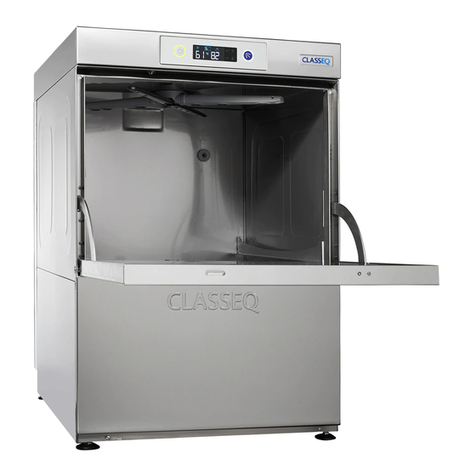
Classeq
Classeq D 400 User manual

Classeq
Classeq D 400 Instruction manual
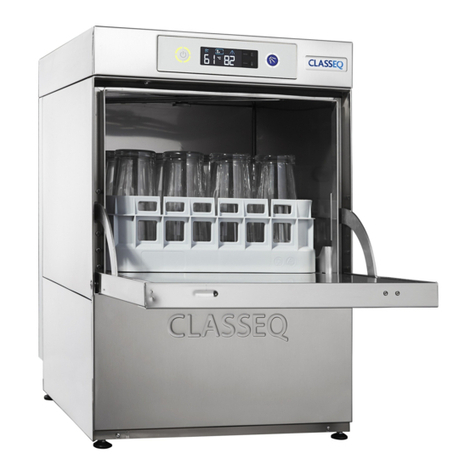
Classeq
Classeq G 350 Quick start guide
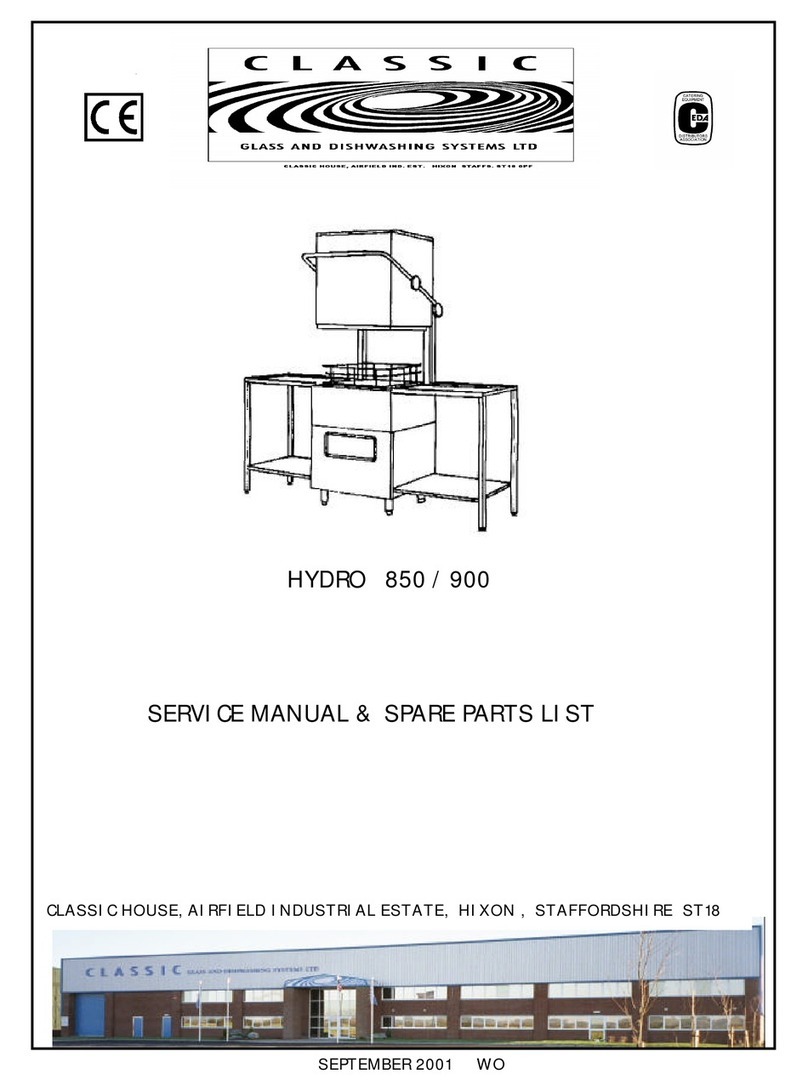
Classeq
Classeq HYDRO 850 User manual
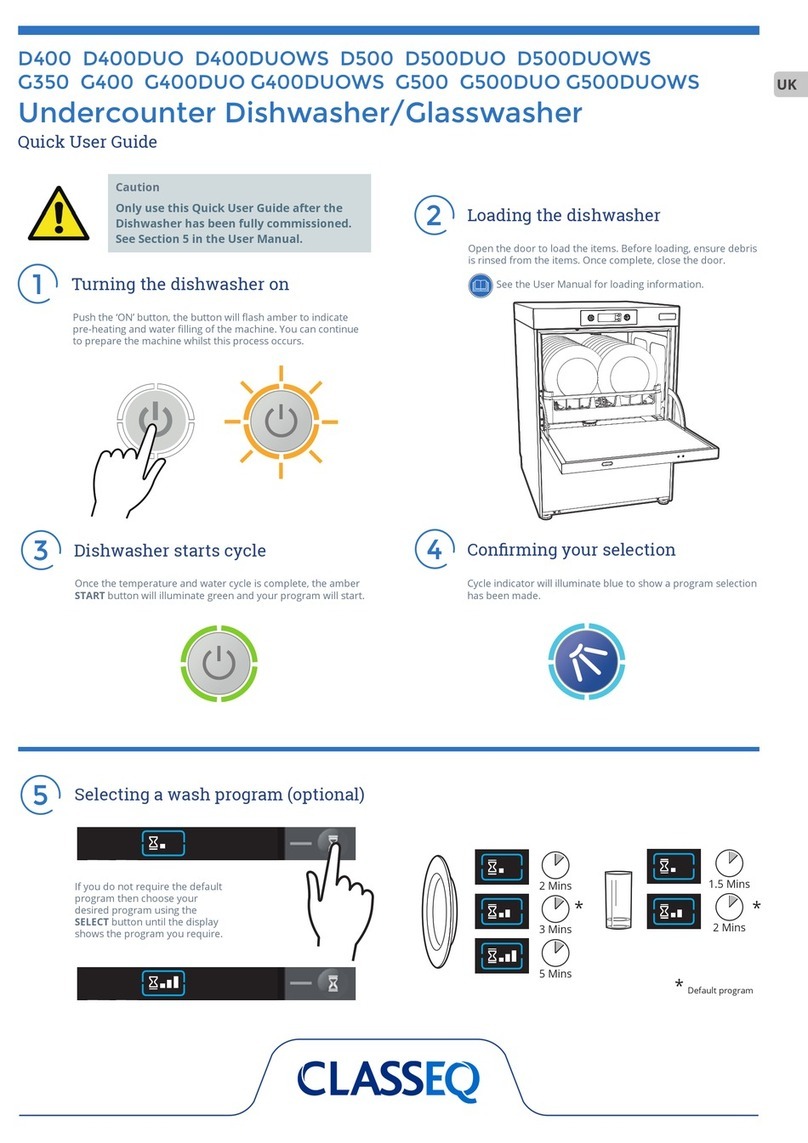
Classeq
Classeq D 400 Instruction manual
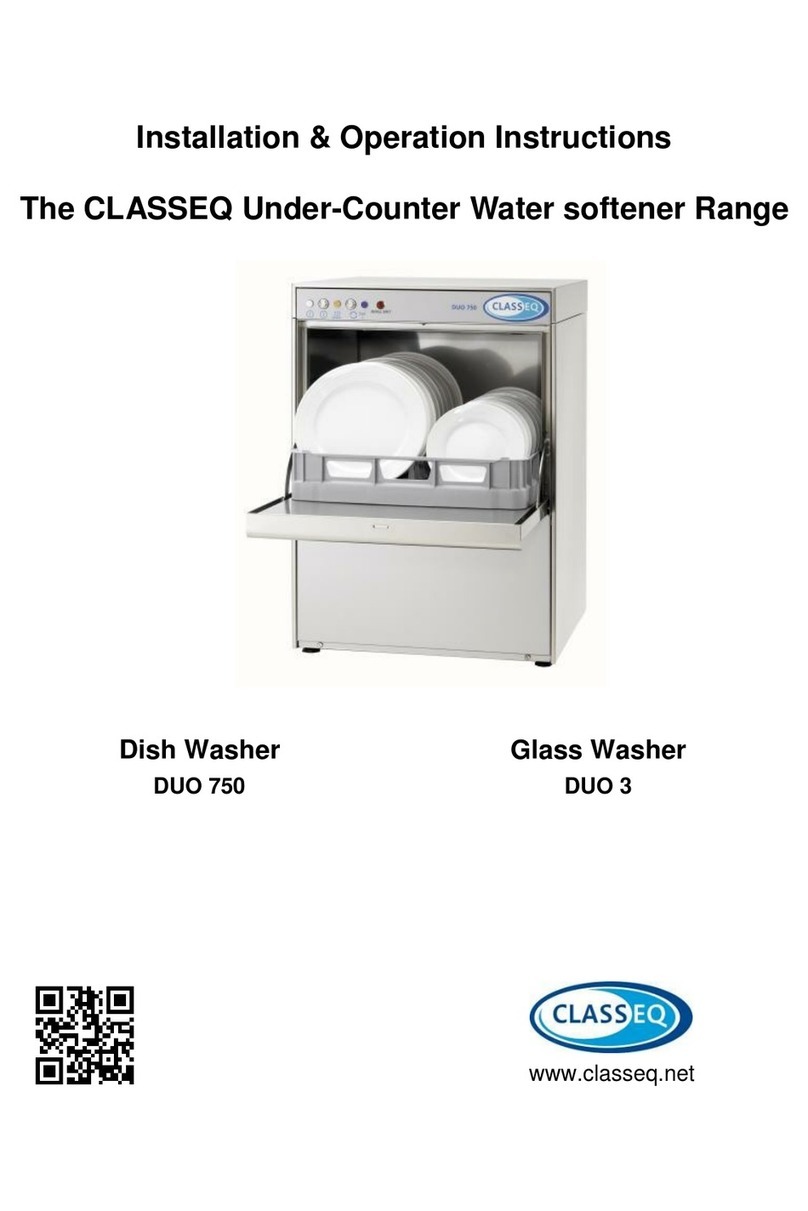
Classeq
Classeq DUO 750 Installation instructions
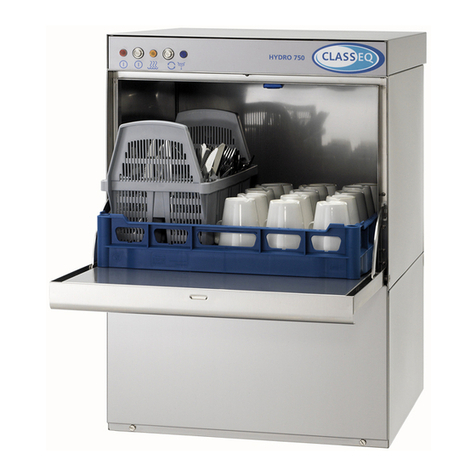
Classeq
Classeq ECO 3 Installation instructions
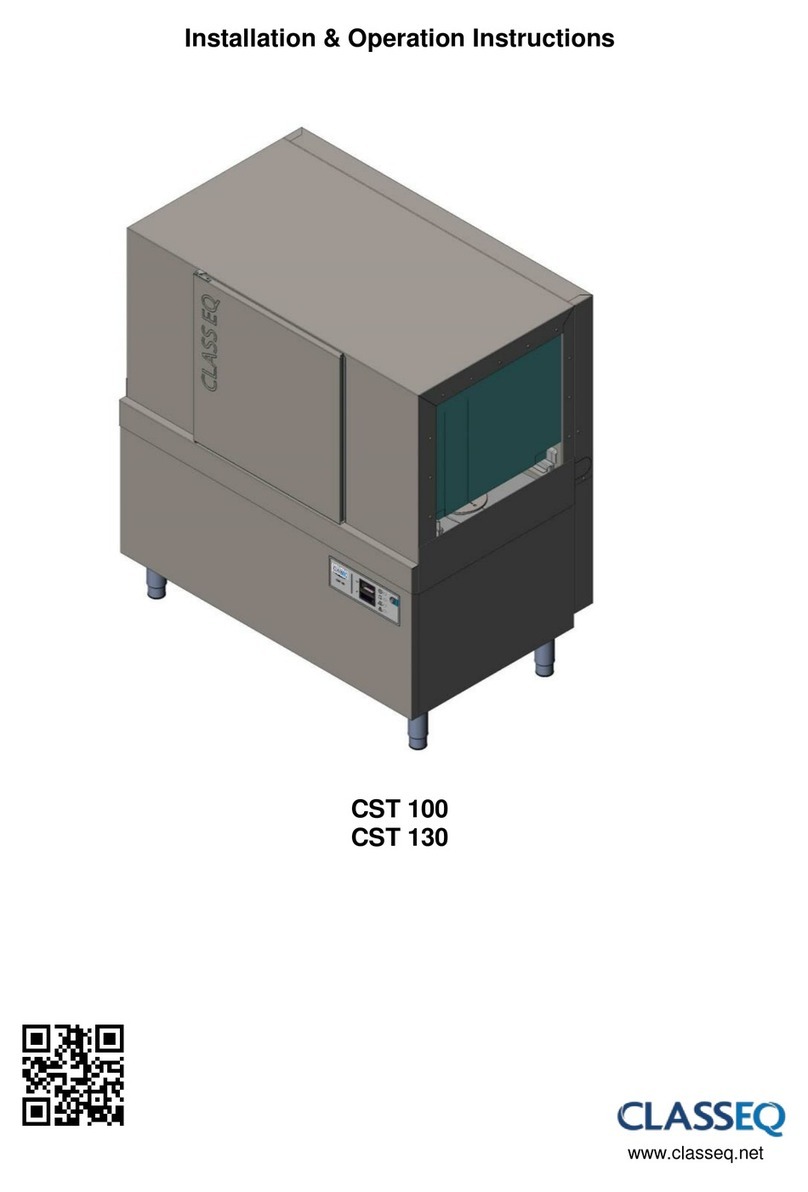
Classeq
Classeq CST 100 Installation instructions
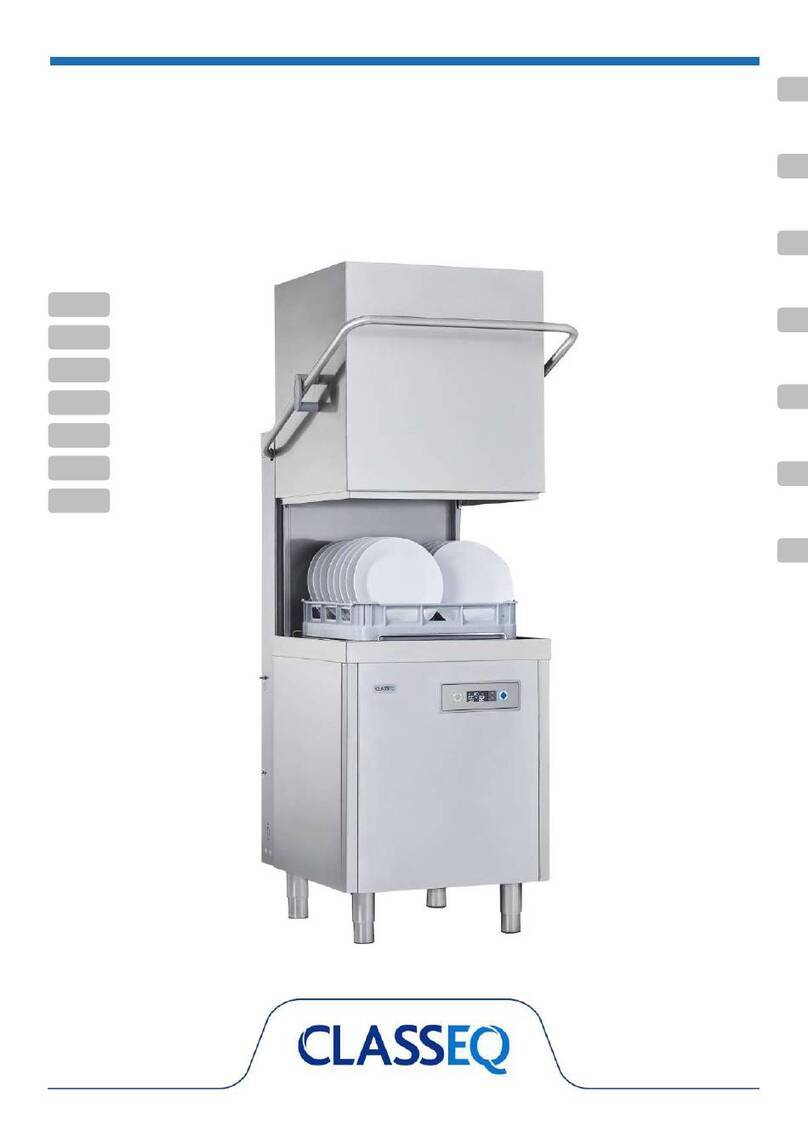
Classeq
Classeq P500A User manual

Classeq
Classeq C200G Administrator Guide
